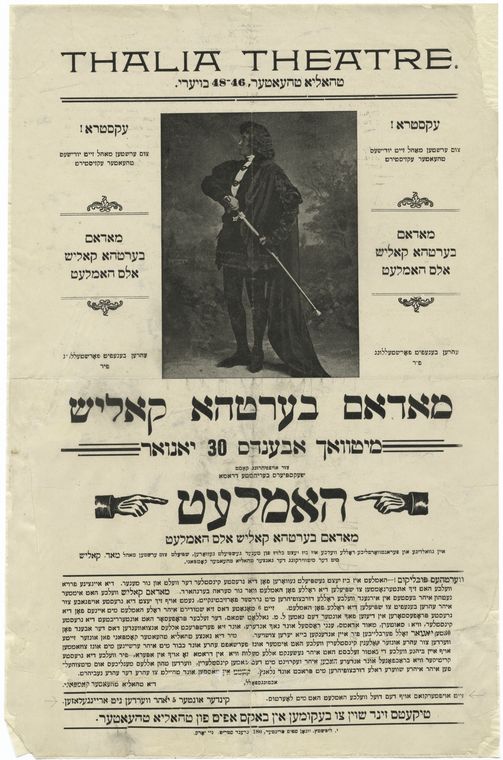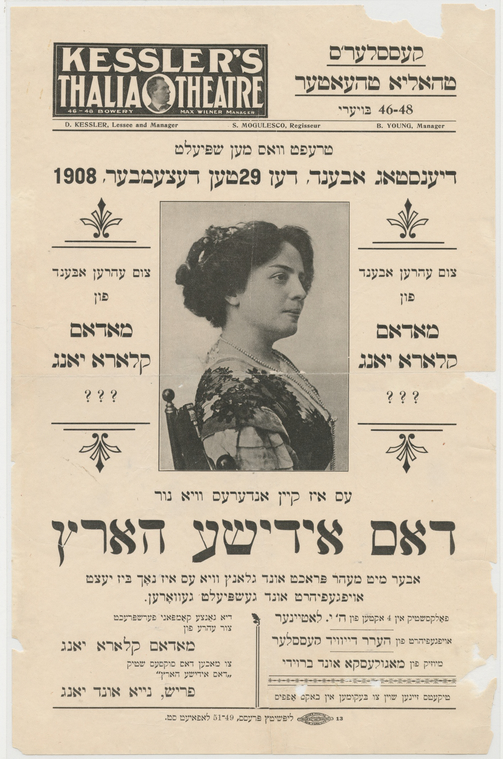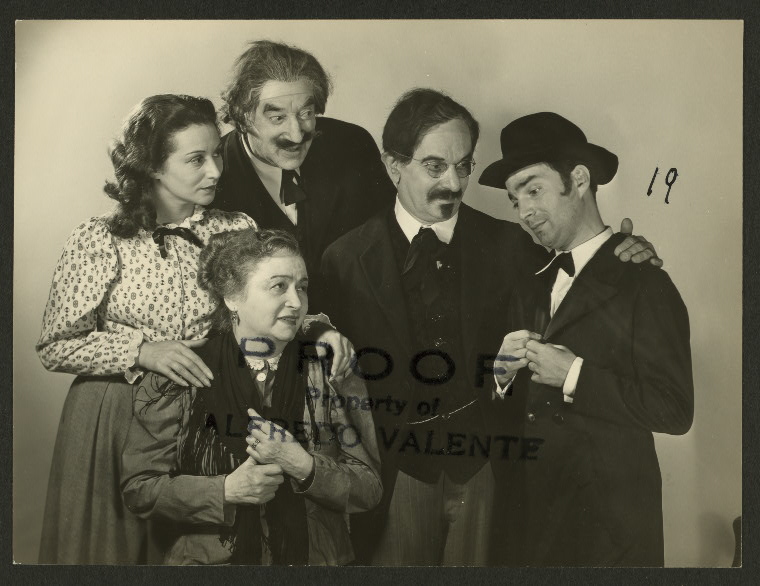The Yiddish Broadway and Beyond
Given New York City’s major role in the Yiddish theater, it’s no surprise that The New York Public Library has a wonderful Yiddish theater collection. Here you’ll find posters, playbills, sheet music, published plays, photographs, manuscripts, memoirs, oral histories and recordings that tell the story of Yiddish theater and its legendary stars.
The images here come from our Digital Gallery, which includes dozens of Yiddish theater posters from New York and Buenos Aires , plus historic photographs from the Yiddish Art Theatre and images of personalities such as Jenny Goldstein, Ludwig Satz, Molly Picon, Maurice Schwartz, Bertha Kalich, Boris and Bessie Thomashefsky, and more.

Image ID: 1689997
New York became a center of Yiddish theater beginning in the late 19th century, when a rising population of Eastern European Jewish immigrants provided an enthusiastic audience and talent pool. New and old Yiddish musicals, dramas, comedies, and translations of world literature supplied entertainment, enlightenment, and community.
Manhattan’s Second Avenue was once known as the Yiddish Broadway, or the Yiddish Rialto. Yiddish theater also played throughout the city, including in the Bronx and Brooklyn.

Image ID: 435111
An Oct. 14, 1908 production of Jacob Gordin’s “Mirele Efros” at the New Star Theater at 107th and Lexington starred Madame Keni Liptsin, and featured Bernard Bernstein and poetry readings by Yehoash (Solomon Blumgarten).
Popular Yiddish theaters in Manhattan included the Thalia Theatre, Windsor Theatre, Yiddish Art Theatre, Grand Theatre, National Theatre, People’s Theatre, Second Avenue Theatre and Yiddish Folks Theatre. At various points, many theaters also carried the names of stars such as Boris and Bessie Thomashefsky, Molly Picon, Jacob P. Adler, Keni Liptsin, and David Kessler. The Hebrew Actors Union, which preceded Actors Equity, still has its headquarters at 31 E. 7th St.

Image ID: TH-56793
The Grand Theater was located at Grand and Chrystie on the Lower East Side.
The Grand Theater was located at Grand and Chrystie on the Lower East Side, and was popular in the early 20th century, featuring plays such as “My People's Dream,” featuring Jacob P. Adler singing “Zay nit gefaln, mayn zindele” (words & music by D. Meyerowitz ; arrangement by Joseph Rumshinsky). Jacob Gordin’s “Got, mentsh un tayvl” [God, man, and devil] was also performed at the Grand in a benefit for the East Side Janitors' Society in 1903. For benefit performances, Jewish communal and hometown organizations would buy large numbers of tickets at a substantial discount and sell them to their members in order to raise funds. Benefits were a popular method for attracting audiences, especially during weekdays.

Image ID: 809928
This photograph of the Thalia Theatre at 46-48 Bowery was taken in 1904.
The Thalia Theater, located at 46-48 Bowery, hosted performances including a Yiddish version of Hamlet (displayed here) starring the renowned multilingual actress and singer, Bertha Kalish. Yiddish translations of Shakespeare, and of other classics of world literature, were an important part of the Yiddish theater repertoire.

Image ID: 436948
This undated advertisement features Bertha Kalich in “Hamlet” at the Thalia Theatre.
The Thalia also hosted popular fare known as “shund” (trash) such as “Dos Idishe harts” [The Jewish heart] by Joseph Latayner, starring Clara Young, in 1908. Latayner was one of the most well-known and prolific Yiddish playwrights of his era, creating superficial and often extravagant plays in a matter of days and shamelessly stealing from existing works.

Image ID: 435083
This poster of Madame Clara Young in “The Jewish Heart” is dated December 29, 1908.
One of Latayner’s rivals was “Professor” Moyshe Horowitz, author of elaborate historical dramas like “The Heroes of Santiago; or, Patriotism and Love,” presented at the Thalia Theatre in 1899, with music by the beloved actor, singer and composer Sigmund Mogulesco.

Image ID: 435138
The heroes of Santiago, or, Patriotism and love. Poster from 1899.
The Yiddish Art Theatre represented a departure from the genre of shund. Founded by the great actor Maurice Schwartz in 1918, the theater focused on works from world literature and serious Yiddish drama, and was steadfastly committed to presenting these “better” plays in the Yiddish language. Schwartz built the Yiddish Art Theatre building at 181 Second Avenue (at E. 12th St.) in 1926. The building still stands today and is used as a movie theater.

Image ID: 1508671
The Second Avenue Theatre (Yiddish Folks Theatre, Yiddish Art Theatre) at 181 Second Avenue (at E. 12th St.).

Image ID: TH-49610
Maurice Schwartz (top) and actors of the Yiddish Art Theatre.
In the Bronx, the Tremont Theatre, at 1942 Webster Avenue, operated for a time as a Yiddish theater. Yiddish theater was also performed at the Bronx Art Theatre, also known at times as the Intimate Playhouse, and the Schildkraut Theatre. The famous Vilna Troupe appeared here, and other Yiddish shows took place at the Bronx’s McKinley Square Theatre.

Image ID: 702036F
Tremont Theatre, Webster Avenue and 178th Street, Bronx.

Image ID: g99c271_001
Ossip Dymov’s Yiddish play, Bronx Express, was also performed in an English adaptation at the Astor Theatre.
Brooklyn’s Parkway Theater, at times also called the Rolland Theater, was located at St. John’s Place and Eastern Parkway in Brownsville. Today, you can find a church on this corner called the “House of Prayer for All People”, as seen in Google Street View. You can view a historic image of the theater in the Brooklyn Collection of the Brooklyn Public Library. There is a small sampling of Yiddish sheet music , some associated with plays produced in Brooklyn, in the Brooklyn Collection of the Brooklyn Public Library. The Hopkinson Theatre, another popular Yiddish venue, was located at Pitkin Avenue and Hopkinson Avenue (now Thomas Boyland Street) in Brownsville, Brooklyn.
 Advertisement for a performance featuring Molly Picon, Jacob Kalich, Pesach’ke Burstyn and Lillian Lux at the Hopkinson Theatre in Brooklyn. Printed in “Der Tog” newspaper, October 18, 1944. Microfilm held by the Dorot Jewish Division, New York Public Library.
Advertisement for a performance featuring Molly Picon, Jacob Kalich, Pesach’ke Burstyn and Lillian Lux at the Hopkinson Theatre in Brooklyn. Printed in “Der Tog” newspaper, October 18, 1944. Microfilm held by the Dorot Jewish Division, New York Public Library.
These are just a few of the many Yiddish theaters in New York City. For more images, search NYPL’s Digital Gallery for the word “Yiddish” and explore. You can also find more information about Yiddish collections in the Library’s catalog and on the website of the Dorot Jewish Division.
The Library’s collection is freely accessible to the public for personal and scholarly research. Please contact the Dorot Jewish Division at dorotjewish@nypl.org to ask questions and request materials.
Online Resources
Read E-Books with SimplyE
 With your library card, it's easier than ever to choose from more than 300,000 e-books on SimplyE, The New York Public Library's free e-reader app. Gain access to digital resources for all ages, including e-books, audiobooks, databases, and more.
With your library card, it's easier than ever to choose from more than 300,000 e-books on SimplyE, The New York Public Library's free e-reader app. Gain access to digital resources for all ages, including e-books, audiobooks, databases, and more.
If you don’t have an NYPL library card, New York State residents can apply for a digital card online or through SimplyE (available on the App Store or Google Play).
Need more help? Read our guide to using SimplyE.
Comments
ARE THERE ANY PICTURES OF THE
Submitted by LURKER TROL (not verified) on July 10, 2016 - 7:40pm
Bronx Ritz Theatre
Submitted by Amanda Seigel on November 10, 2016 - 12:52pm
Berkowitz
Submitted by Judith (not verified) on July 17, 2019 - 1:12pm
Jack Grossman at a Bronx theater
Submitted by G. Marcus (not verified) on November 28, 2020 - 7:41pm
Jack Grossman at a Bronx theater
Submitted by Dorot Jewish Di... (not verified) on December 3, 2020 - 5:23pm